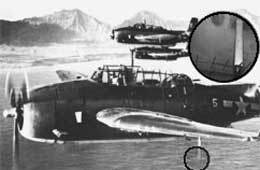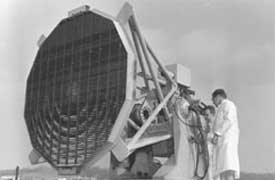U.S Naval Research Lab and the Development of Radar
Although radar research had been ongoing at the U.S Naval Research Laboratory (NRL) in Washington, D.C since the mid-1930s, it wasn’t until the threat of U.S involvement in World War II that the Lab stepped up its radar program. Much as it did for another hub of radar research—MIT's Rad Lab—World War II spurred tremendous growth of the NRL. Employment at the laboratory rose from about 400 in 1941 to 4400 by 1946. Radar development was one of the most important programs at the NRL during that time.
In the United States, radar was born and developed at the NRL in the mid-1930s. Prior to World War II, NRL engineers overcame many obstacles and made great advances in developing radar. These included generating high-pulse power suitable for radar usage; creation of the duplexer, which enabled the transmitter and receiver to be used with a single antenna (as opposed to two separate antennas); development of a suitable map-like display for recognizing and interpreting information provided by the radar; and the development of methods that used the output of the radar for control of an air battle.
Despite these achievements, the value of radar was not fully recognized by the military in the mid-1930s. Program funding was low, as was interest in radar at high levels outside of the NRL. At one point an order was issued to cease all work on radar. Fortunately for the Navy and the United States, the work got done anyway and by about 1939, with war imminent, radar had become a new and valuable asset for the U.S Fleet. Once the United States was drawn into the war, the value of radar was more fully appreciated. The new-found respect for radar led to a long list of achievements at the NRL. Among them was the ASB, the first U.S airborne radar. Operating at a frequency of 500 MHz, over 26,000 units of this “workhorse radar of Naval Aviation” were manufactured, more than any other radar.
Other achievements were the 1941 prototype of the first submarine radar, radars for use on ships for surveillance and gunfire control, and invention of the monopulse tracking technique to give more accurate radar target positions. The last was a very important development that has had a major influence on tracking radars ever since and remains the preferred radar tracking technique when high accuracy is required and/or when military radars are subject to hostile countermeasures. Finally, under NRL leadership, the Combined Research Group was established at NRL. With participants from the United Kingdom, Canada, and the United States, the Combined Research Group was charged with designing and developing an improved Allied “identification friend or foe” system. Used in conjunction with a radar to sort friendly from hostile blips, the NRL’s IFF was the first system to employ separate frequencies for the interrogation of a radar target (that is, it asked, “Who are you?”) and for the target’s reply signal (that is, “I am an Allied airplane.”), which greatly simplified the IFF hardware design. Prior to this, IFF systems had to be compatible with the many different radar frequencies in use since the beginning of the war.
Research and development work conducted at the NRL during World War II made a huge impact on the Allies' ability to win the war and helped shape the technology of the post-war years. The tradition of research and development leading to new radar systems and technology established by those involved at NRL during World War II continues to the present time.

